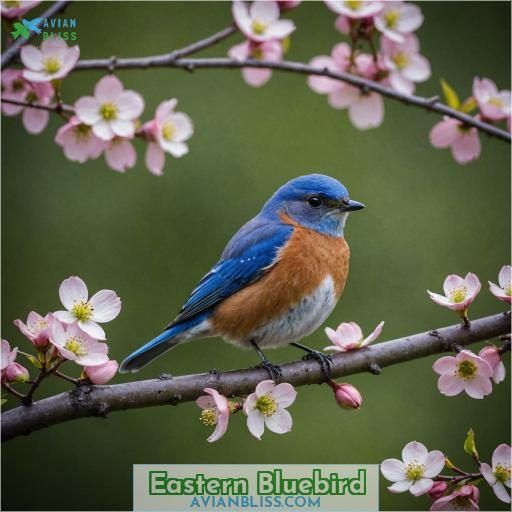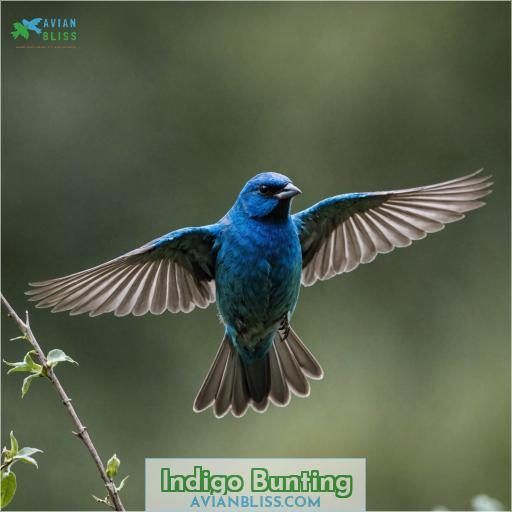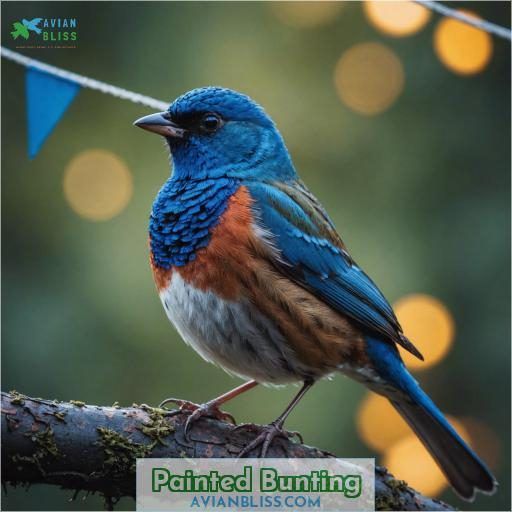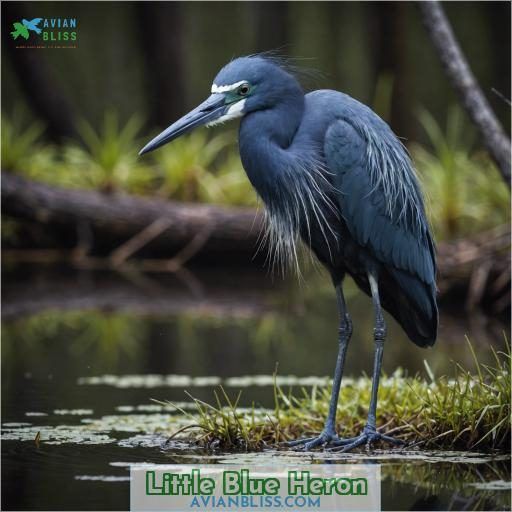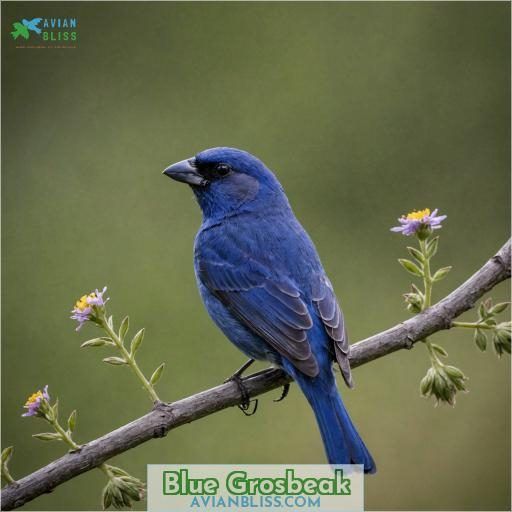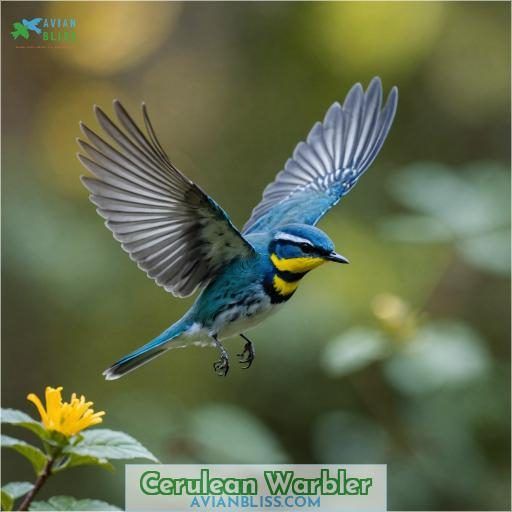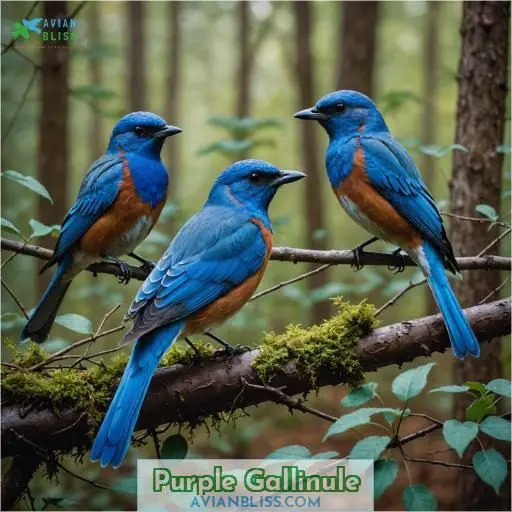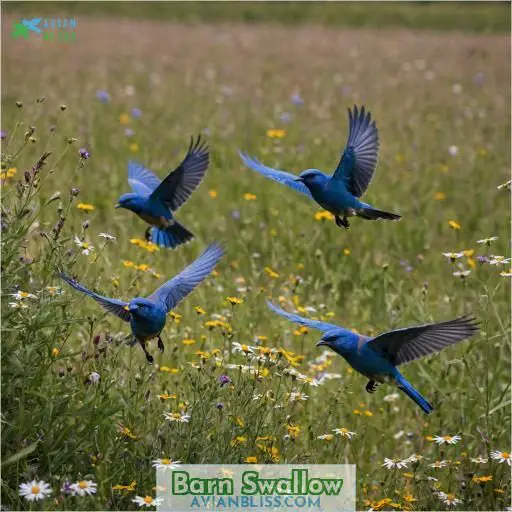This site is supported by our readers. We may earn a commission, at no cost to you, if you purchase through links.
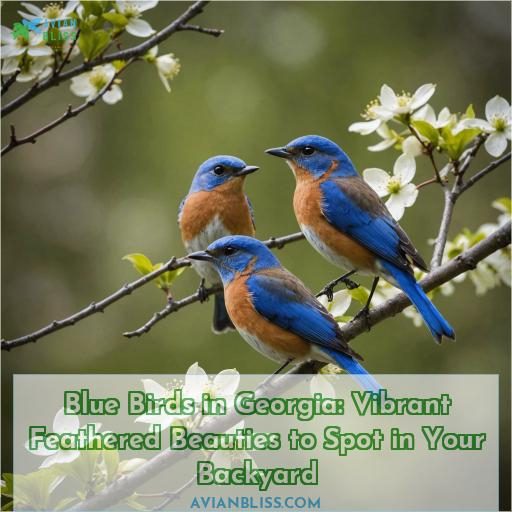 Georgia’s landscapes are graced by a vibrant array of blue birds.
Georgia’s landscapes are graced by a vibrant array of blue birds.
From the brilliant indigo buntings to the regal little blue herons, you’ll spot eastern bluebirds with their vivid blue upperparts and reddish-brown breasts nesting in woodlands and parks.
The boisterous blue jays, adorned in vibrant blues with black collars, frequent deciduous forests and suburban areas.
Brushy thickets harbor the rainbow-colored painted buntings during breeding season.
Explore Georgia’s wetlands to glimpse the blue-gray plumage and white underparts of little blue herons.
These feathered beauties await your keen eye and appreciation for nature’s chromatic splendor – but their stories don’t end here.
Table Of Contents
- Key Takeaways
- Eastern Bluebird
- Blue Jay
- Indigo Bunting
- Painted Bunting
- Little Blue Heron
- Blue Grosbeak
- Cerulean Warbler
- Purple Gallinule
- Barn Swallow
- Frequently Asked Questions (FAQs)
- Do Eastern Bluebirds migrate to Georgia for the winter?
- When is the best time to see Eastern Bluebirds in Georgia?
- How can I attract Eastern Bluebirds to my backyard in Georgia?
- What do Eastern Bluebirds eat during the winter months in Georgia?
- Are Eastern Bluebird populations increasing or decreasing in Georgia?
- Conclusion
Key Takeaways
- Georgia is home to a diverse array of stunning blue birds, including Eastern Bluebirds, Blue Jays, Indigo Buntings, and Little Blue Herons.
- These birds thrive in various habitats across the state, from open woodlands and parks to wetlands and suburban areas.
- Populations of some species, like the Indigo Bunting and Blue Grosbeak, have expanded northward in recent decades, while others face threats from habitat loss and pesticide use.
- Providing native plants, limiting pesticides, and installing properly designed nest boxes can help attract and protect these vibrant blue birds in Georgia.
Eastern Bluebird
The Eastern Bluebird’s range extends across the eastern United States and parts of Canada, thriving in open woodlands, parks, and residential areas. With the male’s vivid blue upperparts and a reddish-brown breast, it’s easy to distinguish from the drabber gray-brown female sporting a subdued blue tint on the wings and tail.
Eastern Bluebird Range Map
The Eastern Bluebird’s range map showcases its migratory patterns across the eastern United States. This vibrant blue bird can be spotted year-round in Georgia, with its population swelling in winter as northern migrants arrive. To attract these beauties to your backyard, provide:
- Nesting boxes
- Native fruit trees and shrubs
- Insect-friendly plants
- Birdbaths
Identifying Male and Female Eastern Bluebirds
Male Eastern Bluebirds flaunt vibrant blue feathers on their backs, wings, and heads, with a rusty red breast. Females are more subdued, sporting gray backs, blue-tinged wings, and a pale orange-brown chest. Both sexes have a small, pointed beak and a rounded head. Identifying Eastern Bluebirds is a breeze with their distinctive blue plumage and compact size.
Blue Jay
The blue jay is a striking bird that graces Georgia’s backyards with its vibrant blue feathers and bold personality.
These intelligent songbirds are year-round residents in the state, with no need to migrate.
Blue jays thrive in a variety of habitats, including deciduous and coniferous forests, parks, and suburban areas.
Known for their loud, harsh calls, blue jays also mimic the sounds of hawks to scare off other birds.
These adaptable birds have a lifespan of 7-10 years and play an important role in seed dispersal and forest regeneration.
With their striking appearance and fascinating behaviors, blue jays are a delight to observe in Georgia’s backyard birding scene.
Indigo Bunting
The indigo bunting’s breeding range stretches across eastern and central United States, with Georgia providing prime habitats for these vibrant songbirds. Male indigo buntings display a brilliant blue plumage that sharply contrasts with the brown color of the females, making them a striking sight in woodlands, thickets, and shrubby areas.
Indigo Bunting Range Map
The indigo bunting’s range has expanded northward in recent decades, likely due to habitat loss and population declines in other species like the blue grosbeak, painted bunting, and lazuli bunting. However, indigo buntings face their own threats from habitat loss and pesticide use. Conservation efforts, such as providing native plants and limiting pesticides, can help protect these vibrant blue birds.
| Habitat | Range | Population | Conservation |
|---|---|---|---|
| Shrubby, brushy areas | Expanding northward | Declining in some areas | Provide native plants, limit pesticides |
Male Indigo Buntings Are a Bright Blue Color
The male Indigo Bunting is a stunning sight with its vibrant blue feathers. This small songbird’s color varies from deep indigo to brilliant azure, depending on the light. Found across the eastern U.S. during breeding season, Indigo Buntings nest in shrubs and low trees, often near forest edges. In fall, they migrate to Mexico and Central America.
- Indigo Buntings are members of the cardinal family.
- They get their name from the blue dye called indigo.
- Females are brown with blue tinges on their wings and tail.
Painted Bunting
After marveling at the indigo bunting’s vibrant blue feathers, keep your eyes peeled for another stunning blue bird – the painted bunting!
During breeding season, male painted buntings flaunt a rainbow of colors, with a bright blue head, red underparts, and green back. Females are olive-green.
These birds prefer brushy areas, thickets, and forest edges. To attract painted buntings, provide native berry-producing shrubs and trees. Offer nyjer seed and suet to supplement their diet of insects and seeds.
Sadly, painted bunting populations are declining due to habitat loss and illegal trapping for the pet trade. Support conservation efforts by keeping cats indoors and avoiding pesticides.
With some luck, you may spot a painted bunting’s kaleidoscopic colors in your Georgia backyard!
Little Blue Heron
The little blue heron is a stunning wading bird that graces Georgia’s wetlands.
These herons breed from New England to Florida, Mexico, and the Caribbean, with some wintering on the Gulf Coast.
They prefer to stand still and wait patiently for prey like fish and amphibians.
During courtship, males perform a neck-stretch display to attract mates, and both sexes build nests in trees alongside other herons.
Clutch sizes vary, with 2-5 eggs laid in Trinidad and 2-4 in Costa Rica.
Young herons can climb around the nest at just 15 days old.
While little blue herons are not endangered, their numbers have declined due to habitat loss and pesticide use.
By providing native plants and avoiding insecticides, you can help these beautiful birds thrive in your Georgia backyard.
Blue Grosbeak
The blue grosbeak’s range spans from the central and eastern United States down into Mexico and Central America. Males of this species display a distinctive indigo blue plumage that makes them easy to identify in Georgia’s backyards and parks.
Blue Grosbeaks Range Map
Blue Grosbeaks are found across the southern U.S. during summer, with their breeding range extending from California to the East Coast. In winter, they migrate to Mexico and Central America. These birds prefer shrubby habitats like overgrown fields and woodland edges. Listen for their rich, warbling songs to spot these vibrant blue beauties in your Georgia backyard!
Male Blue Grosbeaks Have a Distinctive Indigo Blue Color
The male Blue Grosbeak is a sight to behold, with its distinctive indigo blue coloration that stands out in Georgia’s lush habitats. Its large silver bill, chestnut wingbars, and black wings and tail make it easily recognizable. These vibrant birds can be spotted in brushy areas, forest edges, and even suburban backyards across their expanding range in the state.
Cerulean Warbler
After learning about the stunning blue grosbeaks, let’s shift our focus to another blue beauty – the cerulean warbler.
This tiny songbird is a real treat to spot in Georgia’s forests.
With its bright blue back, white belly, and black necklace, the male cerulean warbler is a sight to behold.
Females are more subdued in color but no less charming.
These warblers prefer mature deciduous forests, where they build their cup-shaped nests high up in the canopy.
Sadly, cerulean warbler populations have declined due to habitat loss and fragmentation.
To help these birds, support conservation efforts and plant native trees.
With some luck, you might just catch a glimpse of this elusive azure gem in your local woods.
Purple Gallinule
The striking Purple Gallinule is a sight to behold in Georgia’s wetlands. This colorful bird sports a vibrant purple head, blue back, green wings, and yellow legs.
Gallinules thrive in marshes, swamps, and flooded fields, where they deftly navigate the vegetation using their long toes. These omnivores feast on seeds, berries, insects, and even small fish and frogs.
Gallinules are known for their unique courtship displays, which involve males chasing females and performing elaborate wing-flapping routines. If you’re lucky, you might spot a gallinule’s floating nest, cleverly woven from aquatic plants.
Keep your eyes peeled for this stunning bird on your next Georgia adventure!
Barn Swallow
The barn swallow is a delightful aerial acrobat that graces Georgia’s skies. These agile birds thrive in open areas like pastures, fields, and even suburban parks. Barn swallows construct their cup-shaped nests under eaves, bridges, and in open buildings, using materials like grass, straw, and feathers. Each spring, these long-distance migrants return from wintering grounds as far as Argentina and Australia. Their diet consists mainly of insects, which they catch mid-flight. To help these amazing birds, plant native shrubs and trees, avoid pesticides, and install nest boxes with a 1-inch diameter hole.
- Barn swallows are a symbol of spring’s return
- Their forked tails make them graceful flyers
- Barn swallows are excellent natural pest control
- Protecting barn swallows helps many other species
Frequently Asked Questions (FAQs)
Do Eastern Bluebirds migrate to Georgia for the winter?
Yes, you’ll witness thousands of Eastern Bluebirds migrating to Georgia for winter, mingling with local residents and doubling the population.
When is the best time to see Eastern Bluebirds in Georgia?
Like chasing fleeting glimpses of freedom, the best time to spot Eastern Bluebirds in Georgia is during their winter migration from late October through February. Their vibrant hues bring life to the season.
How can I attract Eastern Bluebirds to my backyard in Georgia?
To attract bluebirds, provide food sources like insect-friendly plants, berry bushes, and fresh water. Install properly-designed nest boxes about 5 feet high, facing a meadow or open space. Monitor regularly, maintaining cleanliness while avoiding disturbances during nesting season.
What do Eastern Bluebirds eat during the winter months in Georgia?
Ah, the winter blues? Fear not, bluebird enthusiasts! In Georgia’s chilly months, these feathered friends feast on a buffet of berries, insects, and seed from your trusty backyard feeders.
Are Eastern Bluebird populations increasing or decreasing in Georgia?
You’ll be glad to know Eastern Bluebird populations are on the rise in Georgia. Thanks to conservation efforts like providing nesting boxes and preserving natural habitats, these delightful songbirds are making a comeback.
Conclusion
Immerse yourself in Georgia’s avian kaleidoscope, where the vibrant hues of blue birds will leave you spellbound.
From the striking eastern bluebirds and regal little blue herons to the radiant indigo buntings and blue grosbeaks, these feathered gems await your discerning eye.
Embrace nature’s chromatic grandeur by exploring Georgia’s diverse habitats.
Each blue-feathered beauty unfurls its enthralling story, inviting you to cherish the wonders of our avian world.

